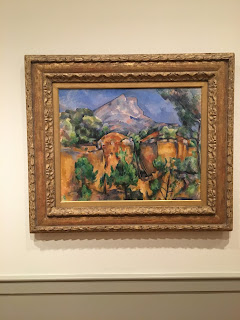Baltimore Museum of Art

The first piece of artwork that piqued my interest was Paul Cezanne's Mont Saeinte-Victoire seen from Bibemus Quarry. This painting features a landscape but is quite different from the traditional landscape painting. Instead of being filled with organic lines illustrating true nature, Cezanne uses more of a geometric concept. The varying line quality gives the audience the perception of depth. In this painting, one can find the compositional elements of the vertical rule of thirds and radiating lines of the mountain structures below the main peak. The second piece I selected was Georgia O'Keeffe's Pink Tulip . This piece is a good example of rhythm. It is very easy to see the movement and flow of the flower. There is a clear and defined use of organic lines, purposely mimicking nature. One can identify the compositional elements of the golden ratio spiral. The third piece, of many, that was salient to me is William Lamb Picknell's Paysa...
